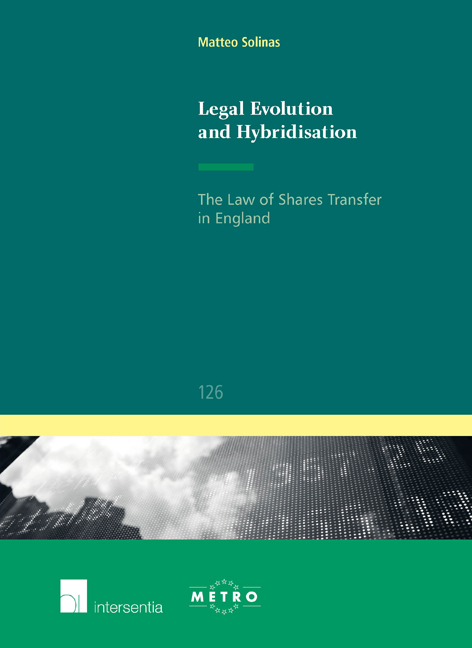Book contents
- Frontmatter
- Foreword
- Preface
- Acknowledgements
- Contents
- Table of Cases
- Introduction
- PART I THE IDEA OF HYBRIDITY IN COMPARATIVE LAW
- PART II THE CIRCULATION OF SHARES
- Introduction to Part II
- Chapter 4 The Transfer of Registered Shares
- Chapter 5 The Transfer of Share Warrants to Bearer
- Summary of Part II
- PART III THE TRANSFER OF (INTERESTS IN) SHARES
- Summary of Part III
- Conclusions
- Bibliography
- IUS COMMUNE EUROPAEUM
Introduction to Part II
from PART II - THE CIRCULATION OF SHARES
Published online by Cambridge University Press: 22 November 2017
- Frontmatter
- Foreword
- Preface
- Acknowledgements
- Contents
- Table of Cases
- Introduction
- PART I THE IDEA OF HYBRIDITY IN COMPARATIVE LAW
- PART II THE CIRCULATION OF SHARES
- Introduction to Part II
- Chapter 4 The Transfer of Registered Shares
- Chapter 5 The Transfer of Share Warrants to Bearer
- Summary of Part II
- PART III THE TRANSFER OF (INTERESTS IN) SHARES
- Summary of Part III
- Conclusions
- Bibliography
- IUS COMMUNE EUROPAEUM
Summary
This Part of the book considers the first leg of the case study on comparative jurisprudence according to the plan outlined at the end of Part I. It examines the historical evolution of the mechanisms by which shares in companies are transferred and refines Watson's thesis on legal transplants with arguments on cultural interaction originating in the postcolonial debate. In doing so, it shows that, contrary to certain preconceptions that claim the joint stock company and its structural elements of association to be ‘Britain's most influential invention’, there is little that is inherently indigenous in its original form. The joint stock company emerged in the sixteenth century with the growth of British trade when certain commercial models borrowed from abroad were progressively integrated into the pre-existing national legal framework. It is argued below that this amounted to a process of hybridisation.
The analysis in this Part has two chapters, Chapters 4 and 5. They explain the mechanism of legal borrowing and the process of reception at the root of the current pattern for the transfer of registered shares and share warrants to bearer, respectively. The reason for the separate inquiry is dictated by the fact that, even if registered shares and share warrants to bearer have the same economic function as units of the corporate capital, they are distinct in terms of their legal nature, regulation and modes of circulation. While in the case of registered shares (unless dematerialised) the certificate is mere evidence of the shares held by the member and title is acquired through entry in the register of shareholders, title to share warrants to bearer is inherent in the physical control of the warrant and passes by manual delivery. It will be shown below that these differences have a historical explanation. More precisely, it will be pointed out that the model for the circulation of registered shares has its origin in the evolution of the scheme of the medieval partnership, and the one for share warrants to bearer has its roots in certain peculiar developments of nineteenth century corporate finance. Even if the seeds of both instruments were not indigenous, they adapted and evolved with peculiar (hybrid) characteristics in the English legal framework.
- Type
- Chapter
- Information
- Legal Evolution and Hybridisation , pp. 49 - 50Publisher: IntersentiaPrint publication year: 2014



